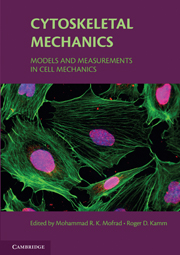Book contents
- Frontmatter
- Contents
- List of Contributors
- Preface
- 1 Introduction, with the biological basis for cell mechanics
- 2 Experimental measurements of intracellular mechanics
- 3 The cytoskeleton as a soft glassy material
- 4 Continuum elastic or viscoelastic models for the cell
- 5 Multiphasic models of cell mechanics
- 6 Models of cytoskeletal mechanics based on tensegrity
- 7 Cells, gels, and mechanics
- 8 Polymer-based models of cytoskeletal networks
- 9 Cell dynamics and the actin cytoskeleton
- 10 Active cellular protrusion: continuum theories and models
- 11 Summary
- Index
7 - Cells, gels, and mechanics
Published online by Cambridge University Press: 10 November 2009
- Frontmatter
- Contents
- List of Contributors
- Preface
- 1 Introduction, with the biological basis for cell mechanics
- 2 Experimental measurements of intracellular mechanics
- 3 The cytoskeleton as a soft glassy material
- 4 Continuum elastic or viscoelastic models for the cell
- 5 Multiphasic models of cell mechanics
- 6 Models of cytoskeletal mechanics based on tensegrity
- 7 Cells, gels, and mechanics
- 8 Polymer-based models of cytoskeletal networks
- 9 Cell dynamics and the actin cytoskeleton
- 10 Active cellular protrusion: continuum theories and models
- 11 Summary
- Index
Summary
ABSTRACT: The cell is known to be a gel. If so, then a logical approach to the understanding of cell function may be through an understanding of gel function. Great strides have been made recently in understanding the principles of gel dynamics. It has become clear that a central mechanism in biology is the polymer-gel phase-transition – a major structural change prompted by a subtle change of environment. Phase-transitions are capable of doing work, and such mechanisms could be responsible for much of the work of the cell. Here, we consider this approach. We set up a polymer-gel-based foundation for cell function, and explore the extent to which this foundation explains how the cell generates various types of mechanical motion.
Introduction
The cell is a network of biopolymers, including proteins, nucleic acids, and sugars, whose interaction with solvent (water) confers a gel-like consistency. This revelation is anything but new. Even before the classic book by Frey-Wyssling a half-century ago (Frey-Wyssling, 1953), the cytoplasm's gel-like consistency had been perfectly evident to any who ventured to crack open a raw egg. The “gel-sol” transition as a central biological mechanism is increasingly debated (Jones, 1999; Berry, et al., 2000), as are other consequences of the cytoplasm's gel-like consistency (Janmey, et al., 2001; Hochachka, 1999). Such phenomena are well studied by engineers, surface scientists, and polymer scientists, but the fruits of their understanding have made little headway into the biological arena.
Perhaps it is for this reason that virtually all cell biological mechanisms build on the notion of an aqueous solution – or, more specifically, on free diffusion of solutes in aqueous solution.
- Type
- Chapter
- Information
- Cytoskeletal MechanicsModels and Measurements in Cell Mechanics, pp. 129 - 151Publisher: Cambridge University PressPrint publication year: 2006
- 12
- Cited by

